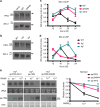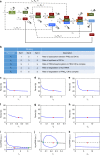FRQ-CK1 interaction determines the period of circadian rhythms in Neurospora
- PMID: 31554810
- PMCID: PMC6761100
- DOI: 10.1038/s41467-019-12239-w
FRQ-CK1 interaction determines the period of circadian rhythms in Neurospora
Erratum in
-
Author Correction: FRQ-CK1 interaction determines the period of circadian rhythms in Neurospora.Nat Commun. 2020 Jan 14;11(1):346. doi: 10.1038/s41467-019-13862-3. Nat Commun. 2020. PMID: 31937790 Free PMC article.
Abstract
Circadian clock mechanisms have been extensively investigated but the main rate-limiting step that determines circadian period remains unclear. Formation of a stable complex between clock proteins and CK1 is a conserved feature in eukaryotic circadian mechanisms. Here we show that the FRQ-CK1 interaction, but not FRQ stability, correlates with circadian period in Neurospora circadian clock mutants. Mutations that specifically affect the FRQ-CK1 interaction lead to severe alterations in circadian period. The FRQ-CK1 interaction has two roles in the circadian negative feedback loop. First, it determines the FRQ phosphorylation profile, which regulates FRQ stability and also feeds back to either promote or reduce the interaction itself. Second, it determines the efficiency of circadian negative feedback process by mediating FRQ-dependent WC phosphorylation. Our conclusions are further supported by mathematical modeling and in silico experiments. Together, these results suggest that the FRQ-CK1 interaction is a major rate-limiting step in circadian period determination.
Conflict of interest statement
The authors declare no competing interests.
Figures





Similar articles
-
FRQ-CK1 Interaction Underlies Temperature Compensation of the Neurospora Circadian Clock.mBio. 2021 Jun 29;12(3):e0142521. doi: 10.1128/mBio.01425-21. Epub 2021 Jun 29. mBio. 2021. PMID: 34182774 Free PMC article.
-
Phosphorylation, disorder, and phase separation govern the behavior of Frequency in the fungal circadian clock.Elife. 2024 Mar 25;12:RP90259. doi: 10.7554/eLife.90259. Elife. 2024. PMID: 38526948 Free PMC article.
-
Regulation of the activity and cellular localization of the circadian clock protein FRQ.J Biol Chem. 2011 Apr 1;286(13):11469-78. doi: 10.1074/jbc.M111.219782. Epub 2011 Feb 7. J Biol Chem. 2011. PMID: 21300798 Free PMC article.
-
Posttranslational regulation of Neurospora circadian clock by CK1a-dependent phosphorylation.Cold Spring Harb Symp Quant Biol. 2007;72:177-83. doi: 10.1101/sqb.2007.72.025. Cold Spring Harb Symp Quant Biol. 2007. PMID: 18419275 Review.
-
The neurospora circadian system.J Biol Rhythms. 2004 Oct;19(5):414-24. doi: 10.1177/0748730404269116. J Biol Rhythms. 2004. PMID: 15534321 Review.
Cited by
-
Differential regulation of phosphorylation, structure, and stability of circadian clock protein FRQ isoforms.J Biol Chem. 2023 Apr;299(4):104597. doi: 10.1016/j.jbc.2023.104597. Epub 2023 Mar 9. J Biol Chem. 2023. PMID: 36898580 Free PMC article.
-
Casein kinase 1 and disordered clock proteins form functionally equivalent, phospho-based circadian modules in fungi and mammals.Proc Natl Acad Sci U S A. 2022 Mar 1;119(9):e2118286119. doi: 10.1073/pnas.2118286119. Proc Natl Acad Sci U S A. 2022. PMID: 35217617 Free PMC article.
-
FRQ-CK1 Interaction Underlies Temperature Compensation of the Neurospora Circadian Clock.mBio. 2021 Jun 29;12(3):e0142521. doi: 10.1128/mBio.01425-21. Epub 2021 Jun 29. mBio. 2021. PMID: 34182774 Free PMC article.
-
An Anatomy of Fungal Eye: Fungal Photoreceptors and Signalling Mechanisms.J Fungi (Basel). 2023 May 19;9(5):591. doi: 10.3390/jof9050591. J Fungi (Basel). 2023. PMID: 37233302 Free PMC article. Review.
-
Intrinsic disorder is an essential characteristic of components in the conserved circadian circuit.Cell Commun Signal. 2020 Nov 11;18(1):181. doi: 10.1186/s12964-020-00658-y. Cell Commun Signal. 2020. PMID: 33176800 Free PMC article. Review.
References
Publication types
MeSH terms
Substances
Grants and funding
LinkOut - more resources
Full Text Sources
Research Materials

